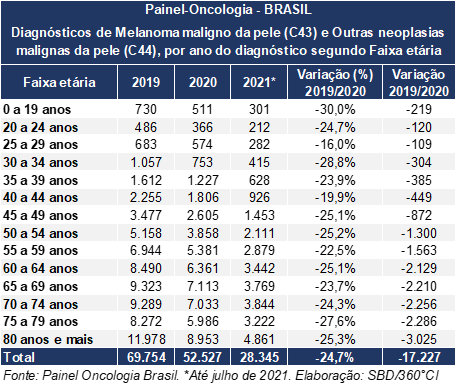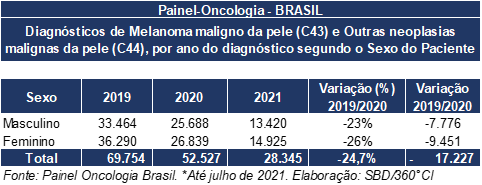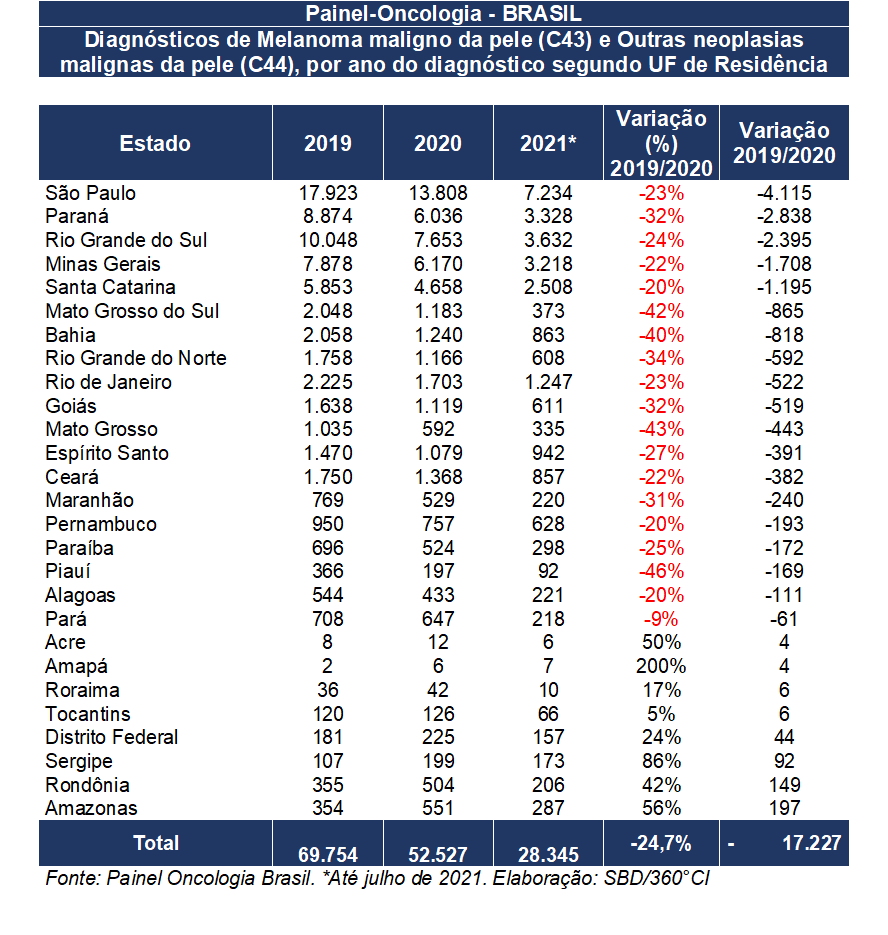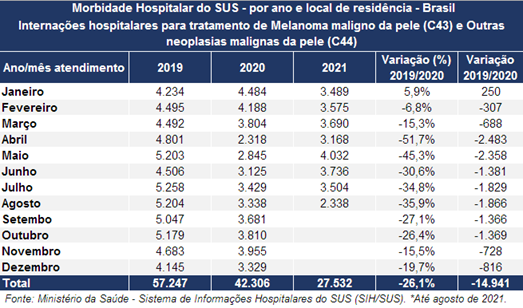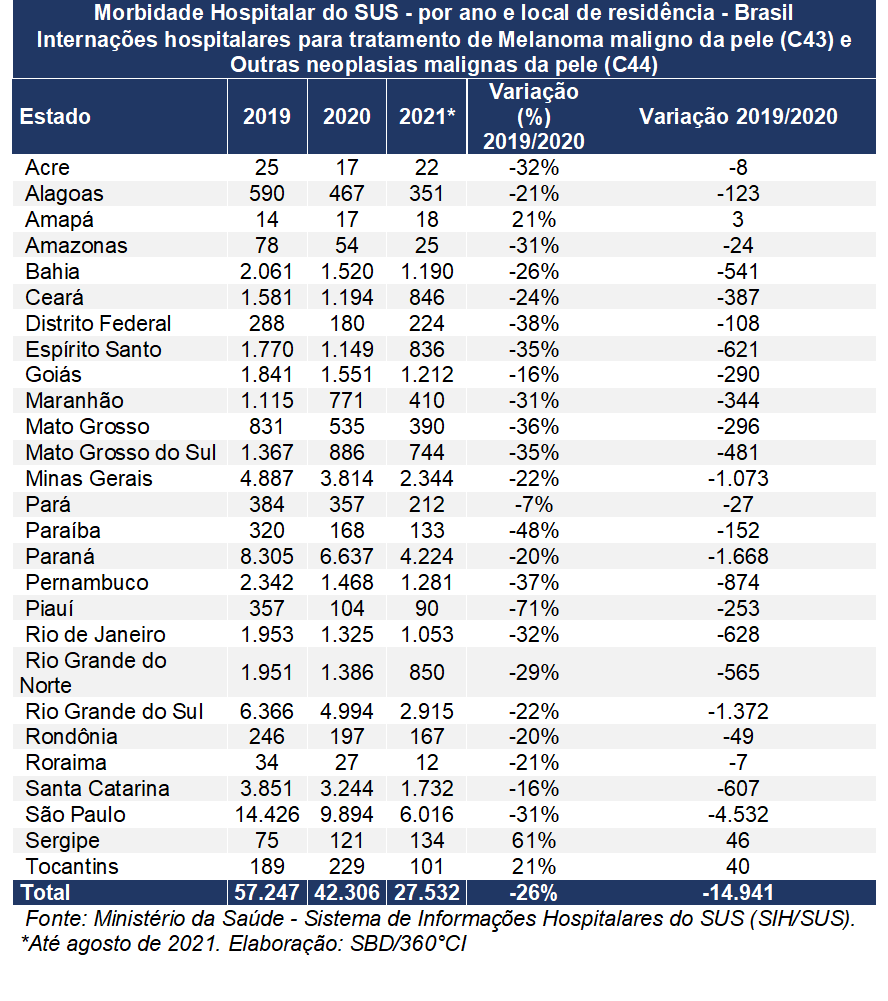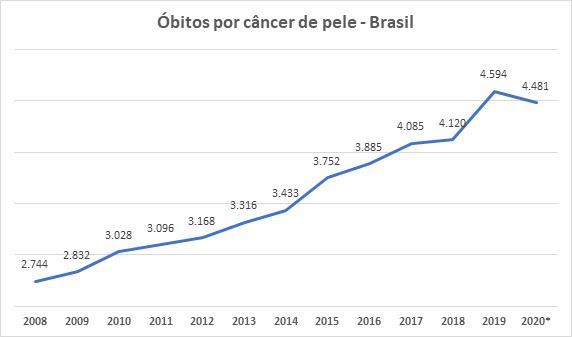Data collected by the Brazilian Society of Dermatology (SBD) point to a troubling reality of efforts to prevent and control skin cancer in the country. In São Paulo, during 2020, the most significant moment of the covid-19 pandemic, 4,115 fewer people were diagnosed with this disease than in 2019. This means that the absolute number of cases was 23% lower than in the period before the spread of the coronavirus.
A national analysis indicates that, overall, skin cancer prevention and control services have been compromised. Throughout 2020, it is estimated that 17,227 diagnoses were no longer made across the country, which is a 24.7% decrease compared to 2019.
Overall, this means that thousands of cases of skin cancer are likely to have their treatments started late or not even detected by doctors, directly affecting patients’ chances of recovery and recovery. In 2021, in the first six months of the year (from January to June), there is a gradual resumption of the amount of aid, although the numbers are still lower than those recorded in the pre-pandemic stage.
The disclosure of these figures coincides with the start of the Orange December campaign organized by the Public Security Directorate, which aims to raise awareness of the risks of skin cancer. In addition to encouraging the integration of light-protection habits into people’s daily lives, the initiative also directs dermatologists to seek guidance if signs and symptoms appear that are worth investigating.
Contamination – In the assessment of SBD specialists, the decline in the number of diagnoses in 2020 is associated with covid-19. Because of the fear of contracting the Coronavirus, on the suspicion that it would be more present in outpatient or hospital settings, thousands of people postponed their checkups and consultations. In addition, many health services have redirected their schedules, restricting patient access or even limiting their care to COVID-19 cases.
According to the figures analyzed by SBD, with a 360° CI consult, in 2020, 52,527 diagnoses of malignant melanoma and other malignant skin tumors were made across the country. This figure is 24.7% lower than the 69,754 reported in 2019. The worst rates were observed in April and May of last year (the months after the country’s public disaster decree) with decreases of -51.7% and -57%, respectively, in terms of detection.
When analyzing the numbers from the patients’ age perspective, it is clear that the age groups most affected are those over 60 years of age. Official information indicates that the deficit in these categories amounted to 11,906 absolute cases in the comparison between 2020 and 2019.
However, it should be noted that from a relative point of view, most sectors showed similar behaviour, focusing on groups 0-19 years (-30%); 30 to 34 years old (-28.8%); and 75 to 79 years (-27.6%). And when segregated by sex, the number of diagnoses fell by 26% among women and 23% among men.
The states with the largest decreases in the number of notifications of melanoma diagnoses were: São Paulo (-4115), Parana (-2.838) and Rio Grande do Sul (-2.395). In terms of percentage, Piaui stands out with a decrease of 46%, Mato Grosso (-43%) and Mato Grosso do Sul (-42%). On the other hand, there was an increase in diagnoses in eight states, with high numbers in Amazonas, Rondônia and Sergipe.
However, the SBD stresses that the numbers may not reflect the epidemiological reality in the country, especially in the north and northeast regions. This is due to problems with updating existing databases, which indicates a framework under notification.
In 2021, the numbers (data / indicators) still do not exceed those that preceded the pandemic, taking into account, above all, the records for the months of April, May and July. Compared to what was accomplished in 2019, the numbers are still 24% lower globally.
Consequences – To broaden the definition of the consequences of the epidemic in hospital care of patients with melanoma, work developed by the Department of Educational Institutions Development also collected a number of hospitalizations related to this type of tumor at SUS. The death toll has also been verified. The analyzed data were extracted from the Brazilian Oncology Panel, Mortality Information System (SIM) and Hospital Information System (SIH/SUS) – all from the Ministry of Health.
In terms of hospital admissions for skin cancer (melanoma) and other malignancies, there was a 26% decrease in the comparison between 2020 and 2019. The number of 57,247 hospital admissions in 2019 decreased to 42,300 last year. In 2021, rates did not exceed the previous outcome of the epidemic. Compared to last year, the numbers are close, but still 27% lower than they were before the arrival of COVID-19 in Brazil.
In this scenario, the worst relative performance was observed in Piauí (-70.8%), Paraíba (-47.6%) and Pernambuco (-37.3%). In absolute terms, the largest declines occurred in São Paulo (-4,532), Parana (-1668), Rio Grande do Sul (-1,373) and Minas Gerais (-1,073). On the other hand, Sergipe and Tocantins are the only states that have increased the number of hospitalizations in the analyzed period, with an increase of 61.3% and 21%, respectively.
With regard to mortality indicators, it is clear that there was no significant change in the assessed periods. Despite the significant decrease in the overall number of new cases of melanoma diagnosed and even hospitalization for its treatment, the number of deaths attributed to this disease showed only fluctuation from 2% to less, compared to 2020 (4481 records) and 2019 (4594). Over a 12-year period (since 2008), it is estimated that 46,534 people have died from this health problem.
Source: Ministry of Health, Mortality Information System. Detail: SBD / 360 ° C

“Wannabe internet buff. Future teen idol. Hardcore zombie guru. Gamer. Avid creator. Entrepreneur. Bacon ninja.”

